Volkswagen Santana
| Volkswagen Santana | |
|---|---|
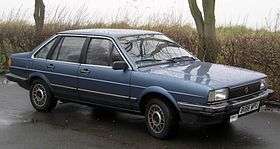 | |
| Overview | |
| Manufacturer |
Volkswagen Nissan Shanghai Volkswagen Automotive |
| Also called |
Shanghai-Volkswagen Santana Volkswagen Quantum Volkswagen Corsar Volkswagen Carat Volkswagen Passat Nissan Santana Ford Versailles |
| Production | 1981-present |
| Assembly |
Argentina Brazil China Germany Japan Mexico |
| Body and chassis | |
| Class | Mid-size car |
| Body style |
2-door saloon/sedan (Latin America) 4-door saloon/sedan 5-door estate/wagon |
| Layout | Front-engine design |
| Platform | Volkswagen Group B2 platform |
| Related | Volkswagen Passat (B2) |
The Volkswagen Santana is a three-box sedan, based on the second-generation Volkswagen Passat (B2). It was introduced in 1981.[1] The use of the "Santana" badge rather than "Passat" echoes the use of different names for the sedan versions of the Polo (Derby) and Golf (Jetta).
In North America, it was also known as the Volkswagen Quantum. In Mexico, it was named the Volkswagen Corsar, while in Argentina it was sold as the Volkswagen Carat. In Brazil and other South American countries it was known as the Santana, while the Passat Variant B2 wagon was marketed as the Volkswagen Quantum. In Europe, the Santana name was dropped in 1985 (with the exception of Spain, where the Santana nameplate was retained) and the car was sold as a Passat. European production ended in 1988.
The final Chinese versions are named Santana Vista, and the name Santana is used on a new 2013 model, slightly smaller and based on the Škoda Rapid and SEAT Toledo.
Santana (China)
The Santana's biggest success was in China. The Santana (B2) had been built in China on a small scale trial basis by the Shanghai Tractor Automobile Corporation (STAC), predecessor of the SAIC group, since 1982.[2][3] The first 100 cars were built from CKD kits delivered from Germany.[4][5] In 1984, Volkswagen signed a contract with STAC, along with the China National Automotive Industry Corporation (CNAIC) and the Bank of China to form the Shanghai Volkswagen Automotive joint venture in October 1984. The first assembly line of the Santana started in October 1985. In September 1986, the 10,000th Santana was built in China.[2] The car and venture laid the ground-works for China's mass motorization.[6] The drive to fully localize production became the impetus for the Chinese auto parts industry: In 1986, the quota of made-in-China parts was below six percent. In 1995, the local content quota stood at 89 percent.[2]
Initially launched with a 1.6-litre petrol engine, the Santana was updated with a 1.8-litre petrol in 1987, first available in the Santana Variant station wagon introduced by Shanghai in 1986.[3] The first Santanas were all originally equipped with a four-speed manual transmission. The 1.6 remained available in the sedan until as late as 2006.
The Santana has had a number of updated features added since the original 1985 model. Some updated features the Santana has been include with are Bosch electronic fuel injection system, a 5-speed manual, a third brake light, improved back seats, hydraulic clutch, MP3 and CD compatible radios, ABS brakes with electronic brake distribution.

In 1991 the Santana 2000 was put into development for China with the aid of Volkswagen do Brasil. It was introduced in 1994 and started mass production in 1995 with a longer wheelbase 2,656 mm (104.6 in) and rear doors than its Brazilian counterpart.

).jpg)
In 2004, the Santana 3000 succeeded the Santana 2000. It was the first design that the Shanghai Volkswagen Automotive joint venture designers had undertaken by themselves. The Santana 3000 was also the first in the Chinese developed Santana series to be available with optional ABS brakes with electronic brake distribution, electronic differential system, a multi function display system, and a sunroof designed by the German Webasto company. The 2.0-litre engine was added to the range in June 2006.
In January 2008, Shanghai Volkswagen Automotive released the Santana Vista (Zhijun) and Santana Vista (Changda) (Taxi model), featuring front and rear visual updates and minor chassis modifications. The Vista can be recognized by its mesh grille, chrome accents located low on the bumpers, and redesigned taillights with circular elements.
As of May 2011 the original German designed Santana (both sedan and Variant versions) was still sold in China alongside the updated Santana Vista,[7] and are still popular with taxi and police fleets, as well as with private buyers. A 1.6-litre version of the Santana Vista (1,595 cc, 70 kW or 95 PS) has been added to the bottom of the lineup to further boost sales. There were 3,213,710 units made since CKD production began in 1983 up until May 2009.[8] Nonetheless, Shanghai Volkswagen Automotive decided to discontinue the Santana in 2012. Production is still continuing in China with the Santana sedan and Gran Santana hatchback.
| Santana 1.6[3] | Santana Variant | Santana 2000 | Santana 3000 1.8 | Santana 3000 Vista 2.0 | Santana Vista 1.6[9] | |
|---|---|---|---|---|---|---|
| Year | 2001 | 2007 | 1997 | 2007 | 2008 | 2011 |
| Body style | 4-door sedan | 5-door estate | 4-door sedan | |||
| Engine | 4-stroke, SOHC Inline 4 | |||||
| Layout | Front, mounted longitudinally at 20° forward angle Front-wheel drive | |||||
| Engine size | 1,598 cc | 1,781 cc | 1,984 cc | 1,595 cc | ||
| Max power | 64 kW (87 PS; 86 hp) at 5,200 rpm | 70 kW (95 PS; 94 hp) at 5,400 rpm | 72 kW (98 PS; 97 hp) at 5,400 rpm | 74 kW (101 PS; 99 hp) at 5,200 rpm | 80 kW (109 PS; 107 hp) at 5,000 rpm | 70 kW (95 PS; 94 hp) at 5,200 rpm |
| Torque | 128 N·m (94 lb·ft) at 3,000 rpm | 145 N·m (107 lb·ft) at 3,000 rpm | 138 N·m (102 lb·ft) at 3,800 rpm | 155 N·m (114 lb·ft) at 3,800 rpm | 168 N·m (124 lb·ft) at 3,800 rpm | 140 N·m (100 lb·ft) at 3,800 rpm |
| Wheelbase | 2,548 mm (100.3 in) | 2,656 mm (104.6 in) | ||||
| Length/width/height (mm) (in) |
4546/1690/1427 179.0/66.5/56.2 |
4546/1710/1427 179.0/67.3/56.2 |
4680/1700/1423 184.3/66.9/56.0 |
4687/1700/1450 184.5/66.9/57.1 | ||
| Unladen Weight | 1,030 kg (2,271 lb) | 1,100 kg (2,425 lb) | 1,120 kg (2,469 lb) | 1,220–1,248 kg (2,690–2,751 lb) | 1,228–1,263 kg (2,707–2,784 lb) | 1,210 kg (2,668 lb) |
| Transmission | 5 MT | 4 MT | 5 MT/4 AT | 5 MT | ||
| Top Speed | 161 km/h (100 mph) | 165 km/h (103 mph) | 172 km/h (107 mph) | 187 km/h (116 mph) AT: 178 km/h (111 mph) |
192 km/h (119 mph) AT: 185 km/h (115 mph) |
181 km/h (112 mph) |
New Santana
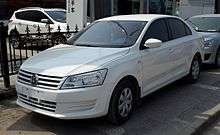
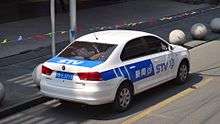
On October 29, 2012, the new Santana was introduced in Wolfsburg, Germany. It was built to fulfil the Chinese market demand. The new Santana is based on the "New AO5+" (PQ25) platform and has been redesigned for more power and a sleeker design.[10]
Its dimensions are: 2,603 mm (102.5 in) wheelbase, 4,473 mm (176.1 in) length, 1,706 mm (67.2 in) width, 1,460 mm (57.5 in) height.[10]
Santana (Japan)
Aiming at a full partnership with Volkswagen, Nissan's then President Takashi Ishihara decided that producing the Santana for the Japanese market would be a good stepping stone. Negotiations began in 1981, and by February 1984, Nissan begun license production of the Santana at its Zama plant in Kanagawa, Japan.[11][12] The Nissan Santana received the internal model code M30. The price of the Nissan Santana was considerably lower than of imported Volkswagens.[13]

Nissan's Santana was changed for Japan with a right hand drive wiper layout (parking on the passenger side) which, as well as a new linkage mechanism, also required a new bonnet pressing as there were recesses in the trailing edge for the wiper pivots. VW-built cars, in common with some of the maker's other models at this time, such as the MKII Golf, had the same LHD wiper pattern regardless of steering wheel location. At introduction, the Nissan Santana was available with three different engines: A 100 PS (74 kW) 1781 cc four (Li, Gi), a 110 PS (81 kW) 1,994 cc five (Gi5, Xi5) and a 72 PS (53 kW) 1,588 cc turbodiesel four (Lt, Gt Diesel Turbo). All came with a five-speed manual transmission as standard, while the gasoline engines were also available with a three-speed automatic.[14] The Nissan Santana was 5 mm narrower than its German counterparts, so as to avoid a massive Japanese tax on cars wider than 1690 mm. Additionally, the grille and headlights were unique to the M30 Santana.
In May 1985 the Xi5 Autobahn version was added to the lineup, offering velour sports seats, electric sunroof and 14-inch alloy wheels. In January 1987 the Santana received a facelift, with a new fascia and new larger bumpers. The Turbodiesel was discontinued, leaving only gasoline-engined versions. The 1.8-litre Gi version was down to 91 PS (67 kW), while the Li and Gi5 equipment grades were dropped. The Xi5 Autobahn was now available with a new engine, however, as a DOHC version of the 2-litre five appeared with 140 PS (103 kW).[14] With sales, originally aimed at 4,000-5,000 per month, only having reached 50,000 over seven years, Nissan ended production in October 1989.[15] Sales of remaining stock continued until May 1990.[16] Instead of renewing the production license, they began selling the new third-generation Volkswagen Passat through their dealer network.[17] As Volkswagen and Toyota began cooperating in 1991, sales of Volkswagens through Nissan dealers came to a halt.
Santana (Brazil)
The Santana entered production in Brazil in June, 1984. It was originally sold as a 4-door and 2-door saloon, but a station wagon named Santana Quantum (later simply Quantum) was launched in July 1985. The 2-door saloon was exclusive to Brazil.
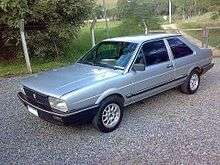
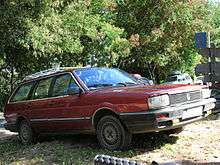
The engine range consisted of two versions of the familiar 1.8-litre Volkswagen EA827 engine, running on ethanol or petrol. In May 1988 it gained the option of a 2.0-litre engine (petrol or ethanol). Thus equipped they were known as Santana/Quantum 2000. Transmissions included a 4-speed manual (for the first two years), 5-speed manual (first as an option but made standard in 1987), and for the top line CD (later GLS) a 3-speed automatic.
In 1991, Volkswagen do Brasil then engaged in a joint venture with Ford called AutoLatina, decided to retain the Passat (B2) shaped saloon and wagon instead of building the newer third-generation Passat (B3). Thorough changes to the bodyshell, boot line, front and rear guards, meant it looked considerably more modern than its predecessor, if not quite at par with the B3. Under the terms of AutoLatina, this "new" Santana was also marketed as the Ford Versailles in Brazil and as the Ford Galaxy in Argentina. The 3-door (later 5-door) station wagon was sold as the Ford Royale. 1991 also marked the introduction of ABS brakes and catalytic converters, both firsts for the Brazilian car industry.[18]
It received a small facelift for 1994, and another more extensive one in 1998. In 2002, the Quantum was taken out of production, and then, after more than two decades and years of dropping sales, the Santana was retired from the range in June 2006. It sold 548,494 units during its production run.
| Engine | 2.0L 8v I4 (VW EA827/ AP-2000) |
| Layout | Front engine, Front-wheel drive |
| Transmission | 5-speed manual |
| Power | 113 hp (84 kW) @ 5250 rpm |
| Length | 4,600 mm (181.1 in) |
| Width | 1,700 mm (66.9 in) |
| Height | 1,420 mm (55.9 in) |
| Wheelbase | 2,550 mm (100.4 in) |
| Weight | 1,160 kg (2,557 lb) |
| Acceleration 0–100 km/h (0-62 mph) | 9.9 sec |
| Top speed | 191 km/h (119 mph) |
Corsar (Mexico)

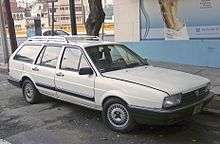
The Santana was launched to the Mexican car market in February 1984 as the all-new Corsar CD. Assembled at VW Mexico's Puebla factory mostly with German-sourced components, for the brand it was intended to be the top-of-range offer for the domestic car market at the time, a mechanically reliable while slightly luxurious medium sedan. The 1.8-litre 85 hp (63 kW) carbureted engine was the only drive choice for the whole Corsar lineup through its lifetime. It was definitely a high fuel-saving option toward its local medium-luxury competitors: Chrysler LeBaron "K", Chevrolet Celebrity, Ford Grand Marquis, Renault 18.
In 1984 and 1985, the Corsar was marketed only as 4-door sedan, the same European Santana body (no Passat Variant body was offered here for those first years), matching the appearance of the USA's market version (badged there as VW Quantum). At the time, the Corsar and Quantum saloons shared the same front grille design, featuring four squared headlight units (two beams for the right and left sides with amber-coloured rectangular emergency indicators below each) rather than the Santana's grille design.
Regarding equipment, only one trim level was available, which included: 13” alloy wheels, 185/70 tires, velour upholstery (gray or blue coloured starting in 1985), rear seat headrests, AM/FM stereo cassette Radio with 4 speakers, tachometer, power steering, anti-theft alarm. Air condition was available as an option, as well as 4-speed manual transmission or 3-speed automatic gearboxes. The following colours were available for 1984: Mars Red, Alpine White, Jade Green Metallic, Cosmos Silver Metallic and Graphite Metallic.
For 1986, the Corsar's product range received several novelties, somewhat similar to the North-American Quantum line. First, the headlights and front grille design was updated to match the same featured by the correspondent European Passat line. New body colours and upholstery types were now offered, a new 5-speed manual gearbox replaced the previous 4-speed one. Some new features were now available as option equipment, mainly power door locks and windows and black leather upholstery. In March 1986, the Passat wagon body was now offered within the local lineup, being badged here as Corsar Variant (matching the European Passat Variant or Quantum Wagon, as known in USA and Brazil).
The 1987 and 1988 Corsar lineup remained mostly unchanged, just bringing out then that the alloy wheels where now offered as part of the option package, with a set of steel-made wheels wearing full covers being now the standard ones.
By mid-1988, a limited edition Corsar was released (both saloon and Variant version). It was distinguished for its Black and Silver double-tone paintwork, black leather upholstery and full equipment. Finally, by the end of 1988, the Corsar was discontinued from Volkswagen Mexico lineup, since production of its German counterpart -the Santana/Passat Mk2- stopped in Europe (where most of the matching parts came from, and rather started producing the next gen Passat Mk3). Also, the local assembly lines were needed by VW to increase the production run of the Mk2 Golf/Jetta for USA and Canada exports. In Mexico, the Corsar is still well remembered as a sleek design, good reputation vehicle.
Carat (Argentina)
The Santana 4-door sedan started production in Argentina in June, 1987 as the Carat, manufactured by Volkswagen Argentina S.A. (San Justo/General Pacheco, Buenos Aires Province). Production ended in 1991.
| Model | GS 1.8/CD | CD 2.0 |
|---|---|---|
| Introduced | 1987 (GS: 1989) | 1989 |
| Engine | Volkswagen-Audi 827 AP 1,8/2.0 4-stroke, SOHC Inline 4 | |
| Layout | Front, mounted longitudinally at 20° forward angle Front-wheel drive | |
| Transmission | Five-speed manual | |
| Final drive ratio | 5.140:1 | 4.111:1 |
| Cooling | Water (6.1 liters) | |
| Fuel Type | Super gasoline | |
| Wheelbase (mm) | 2550 | |
| Track front/rear (mm) | 1414/1422 | |
| Length/Width/Height (mm) | 4527/1708/1395 | |
| Weight (kg) | 1081 | |
| Fuel Capacity (l) | 75 | |
| Steering | Rack and pinion, 3.9 turns lock to lock | |
| Brakes front/rear | disc/drum, servo | |
| Front suspension | Independent, by MacPherson, wishbones, coil springs/telescopic damper struts, anti-roll bar | |
| Rear suspension | Self-stabilizing axle with v-shaped profile, longitudinal arms, coil springs, telescopic dampers | |
| Tyres/wheels | 185/70 MR 13, 5.5" wide rims | |
| Alternator | 12V 55A | |
| Displacement (cc) | 1781 | 1984 |
| Bore/stroke (mm) | 81.0 x 86.4 | 82.5 x 92.8 |
| Compression | 9.0:1 | 8.5:1 |
| Peak power | 70.5 kW (96 PS) | 73.5 kW (100 PS) |
| at rpm | 5,500 | 5,200 |
| Peak torque | 14.6 kg·m (143 N·m; 106 lb·ft) | 162 N·m (119 lb·ft) |
| at rpm | 2,600 | 3,400 |
| Fuel system | Pierburg Brosol 2E7 twin-barrel downdraught carburator | |
| Fuel consumption | 10.0 km/L (10.0 L/100 km) | 11.2 km/L (8.9 L/100 km) |
| Acceleration 0–100 km/h | 12.9 s | 12.4 s |
| Top speed (km/h) | 168 | 171 |
| Equipment | Air conditioning, power locks, power windows | |
References
- ↑ Per-Olof Larsson, 1 December 2012, Good design. The legendary Volkswagen Santana, www.guexed.com Retrieved 23 December 2016
- 1 2 3 Posth, Martin (2006), 1000 Days in Shanghai, Singapore: John Wiley & Sons (Asia), ISBN 978-0-470-82388-0
- 1 2 3 World of Cars 2006·2007. Warsaw, Poland: Media Connection Sp. z o.o. 2006. pp. 238, 394–395.
- ↑ Auto Katalog 1983. Stuttgart: Vereinigte Motor-Verlage GmbH & Co. KG. 1982. p. 61.
- ↑ Auto Katalog 1984. Stuttgart: Vereinigte Motor-Verlage GmbH & Co. KG. 1983. pp. 60–61.
- ↑ "Santana R.I.P.". The Truth About Cars. Retrieved 2010-07-03.
- ↑ "上海大众桑塔纳SANTANA Vista 1.6L 舒适型 (5MT) 配置表" [Shanghai Volkswagen Santana Vista 1.6L Comfortline (5MT) configuration table] (in Chinese). Shanghai Volkswagen. Retrieved 2011-05-18.
- ↑ "News Shocker: VW to kill of Santana production in 2012". China Car Times. 2009-05-15. Retrieved 2009-05-28.
- ↑ "上海大众桑塔纳SANTANA 舒适型1.6L 配置表" [Shanghai Volkswagen Santana 1.6L configuration table] (in Chinese). Shanghai Volkswagen. Retrieved 2011-05-18.
- 1 2 杜铭蔚 (2012-10-30). 二十九年的蜕变 大众新桑塔纳全球首发 [World premier of an all-new Santana, after 29 years] (in Chinese). Shanghai: 中华网汽车 (Auto China.com).
- ↑ "Internationalization Strategies. Japan's Auto Industry. About JAMA". Jama.org. Retrieved 2010-07-03.
- ↑ "NISSAN | CORPORATE INFORMATION | Outline of Company|Company Development, Heritage | 1980's". Nissan-global.com. Retrieved 2010-07-03.
- ↑ Auto Katalog 1986. Stuttgart: Vereinigte Motor-Verlage GmbH & Co. KG. 1985. p. 124.
- 1 2 "Catalog: Volkswagen Santana". CarSensorLab. Archived from the original on 2010-07-06.
- ↑ "Nissan Engine Number". Nissan Parts Australia. Retrieved 28 January 2014.
- ↑ "Car Life: Nissan: VW Santana". Goo-net. Retrieved 2010-07-06.
- ↑ Auto Katalog 1991. Stuttgart: Vereinigte Motor-Verlage GmbH & Co. KG. 1990. p. 83.
- ↑ Calmon, Fernando (2013-04-02). Just-Auto global news. Aroq Limited. Missing or empty
|title=(help)
External links
![]() Media related to Volkswagen Santana at Wikimedia Commons
Media related to Volkswagen Santana at Wikimedia Commons
« previous — Volkswagen Passenger Cars, a marque of the Volkswagen Group, car timeline, European market, 1980s–present | ||||||||||||||||||||||||||||||||||||||
|---|---|---|---|---|---|---|---|---|---|---|---|---|---|---|---|---|---|---|---|---|---|---|---|---|---|---|---|---|---|---|---|---|---|---|---|---|---|---|
| Type | 1980s | 1990s | 2000s | 2010s | ||||||||||||||||||||||||||||||||||
| 0 | 1 | 2 | 3 | 4 | 5 | 6 | 7 | 8 | 9 | 0 | 1 | 2 | 3 | 4 | 5 | 6 | 7 | 8 | 9 | 0 | 1 | 2 | 3 | 4 | 5 | 6 | 7 | 8 | 9 | 0 | 1 | 2 | 3 | 4 | 5 | 6 | 7 | |
| Economy car | Beetle | |||||||||||||||||||||||||||||||||||||
| City car | Lupo | Fox | up! | |||||||||||||||||||||||||||||||||||
| Supermini | Polo / Derby I | Polo / Derby II | Polo III | Polo IV | Polo V | |||||||||||||||||||||||||||||||||
| Small family car | Golf I | Golf II | Golf III | Golf IV | Golf V | Golf VI | Golf VII | |||||||||||||||||||||||||||||||
| Jetta I | Jetta II | Vento | Bora | Jetta V | Jetta VI | |||||||||||||||||||||||||||||||||
| New Beetle | Beetle | |||||||||||||||||||||||||||||||||||||
| Large family car | Passat I | Passat II / Santana | Passat III | Passat IV | Passat V | Passat VI | Passat VII | Passat VIII | ||||||||||||||||||||||||||||||
| Passat CC | CC | Arteon | ||||||||||||||||||||||||||||||||||||
| Luxury car | Phaeton | |||||||||||||||||||||||||||||||||||||
| Coupé | Scirocco I | Scirocco II | Scirocco III | |||||||||||||||||||||||||||||||||||
| Corrado | ||||||||||||||||||||||||||||||||||||||
| Convertible | Golf I Cabriolet | Golf III Cabriolet | Golf VI Cabriolet | |||||||||||||||||||||||||||||||||||
| New Beetle Cabriolet | Beetle Cabriolet | |||||||||||||||||||||||||||||||||||||
| Eos | ||||||||||||||||||||||||||||||||||||||
| Compact MPV | Golf Plus | Golf Sportsvan | ||||||||||||||||||||||||||||||||||||
| Touran I | Touran II | |||||||||||||||||||||||||||||||||||||
| Large MPV | Sharan I | Sharan II | ||||||||||||||||||||||||||||||||||||
| SUV | Tiguan I | Tiguan II | ||||||||||||||||||||||||||||||||||||
| Touareg I | Touareg II | |||||||||||||||||||||||||||||||||||||
| ||||||||||||||||||||||||||||||||||||||